
Mites are small arachnids. Mites span two large orders of arachnids, the Acariformes and the Parasitiformes, which were historically grouped together in the subclass Acari. However, most recent genetic analyses do not recover the two as each other's closest relative within Arachnida, rendering the group non-monophyletic. Most mites are tiny, less than 1 mm (0.04 in) in length, and have a simple, unsegmented body plan. The small size of most species makes them easily overlooked; some species live in water, many live in soil as decomposers, others live on plants, sometimes creating galls, while others again are predators or parasites. This last type includes the commercially destructive Varroa parasite of honey bees, as well as scabies mites of humans. Most species are harmless to humans, but a few are associated with allergies or may transmit diseases.
Acariasis is an infestation with mites.

Parasitiformes are a superorder of Arachnids, constituting one of the two major groups of mites, alongside Acariformes. Parasitiformes has, at times, been classified at the rank of order or suborder.
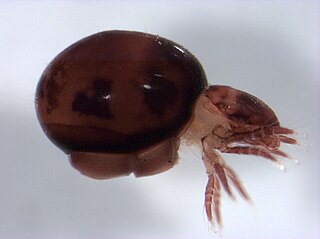
Oribatida, also known as oribatid mites, moss mites or beetle mites, are an order of mites, in the "chewing Acariformes" clade Sarcoptiformes. They range in size from 0.2 to 1.4 millimetres. There are currently 12,000 species that have been identified, but researchers estimate that there may be anywhere from 60,000 to 120,000 total species. Oribatid mites are by far the most prevalent of all arthropods in forest soils, and are essential for breaking down organic detritus and distributing fungi.

Tydeidae is a family of acariform mites. As of 2016, it contained over 300 species in three subfamilies, though more species have been discovered since then.
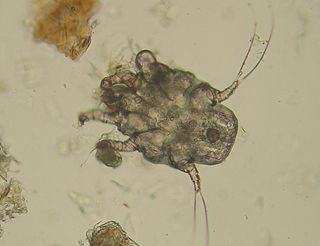
Astigmatina is a clade of mites in the superorder Acariformes. Astigmata has been ranked as an order or suborder in the past, but was lowered to the unranked clade Astigmatina of the clade Desmonomatides in the order Sarcoptiformes. Astigmatina is now made up of the two groups Acaridia and Psoroptidia, which have been suborders of the order Astigmata in the past. Astigmatina contains about 10 superfamilies and 76 families under Acaridia and Psoroptidia.
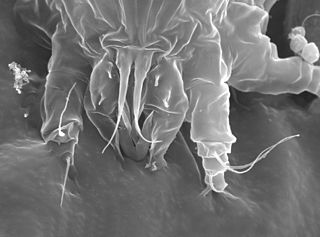
Eriophyoidea are a superfamily of herbivorous mites. All post-embryonic instars lack the third and fourth pairs of legs, and the respiratory system is also absent.

The Prostigmata is a suborder of mites belonging to the order Trombidiformes, which contains the "sucking" members of the "true mites" (Acariformes).
The Raphignathoidea is a superfamily of the Acari (mite) order Trombidiformes, comprising 1087 species in 62 genera and 12 families.

The Trombidiformes are a large, diverse order of mites.

Hydrachnidia, also known as "water mites", Hydrachnidiae, Hydracarina or Hydrachnellae, are among the most abundant and diverse groups of benthic arthropods, composed of 6,000 described species from 57 families. As water mites of Africa, Asia, and South America have not been well-studied, the numbers are likely to be far greater. Other taxa of parasitengone mites include species with semi-aquatic habits, but only the Hydracarina are properly subaquatic. Water mites follow the general Parasitengona life cycle: active larva, inactive (calyptostasic) protonymph, active deutonymph, inactive tritonymph and active adult. Usually, larvae are parasites, while deutonymphs and adults are predators.
Archegozetes longisetosus is a species of tropical moss mite in the family Trhypochthoniidae. It has been used as a model organism and has been found to have a very high pulling strength relative to its size.
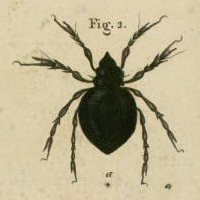
Damaeidae Berlese (1896) is a family of mites. Alternative names for the family include Belbidae Willmann (1931), and Belbodamaeidae Bulanova-Zachvatkina (1967) or Hungarobelbidae (1996). They had been previously considered to be distinct families.
Plateremaeidae is a family of oribatids in the order Sarcoptiformes. There are about 7 genera and 19 described species in Plateremaeidae.

Winterschmidtiidae is a family of mites in the order Astigmata.

Halacaridae is a family of meiobenthic mites found in marine, brackish, and freshwater habitats around the world. It includes more than 1100 described species belonging to 64 genera It is the largest marine radiation of arachnids.
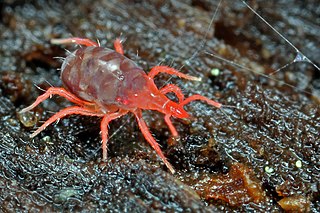
Bdellidae is a family of snout mites in the order Trombidiformes. There are about 11 genera and at least 260 described species in Bdellidae.

Neotrombidiidae is a family of velvet mites and chiggers in the order Trombidiformes. There are at least four genera in Neotrombidiidae.

Oripodoidea is a superfamily of oribatids in the order Oribatida. There are about 19 families and at least 1,300 described species in Oripodoidea.

Kiwalges haastii is a species of New Zealand feather mite in the superfamily Analgoidea, known only from the great spotted kiwi, from which it derives its name.

















